How To Connect A Propane Grill To House Propane Supply
Disclaimer: You really should consult a certified gas fitter for this type of project. Be sure to check all local building codes prior to attempting a project of this nature.
Connecting Gas Grill To House Propane Supply
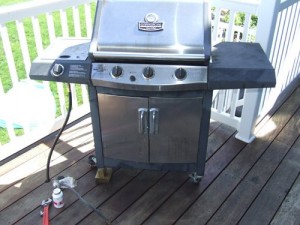 Connecting your propane gas grill to your house propane supply is a great way to ensure you can cook dinner anytime without running out of gas. This can be a fairly straight forward home improvement project if you have an accessible gas line near the grill.
Connecting your propane gas grill to your house propane supply is a great way to ensure you can cook dinner anytime without running out of gas. This can be a fairly straight forward home improvement project if you have an accessible gas line near the grill.
In my case I had the plumbers run a gas line outside just under the deck when we built the house. They ran the gas line outside and left it with a shut-off valve so that I could connect it to my grill.
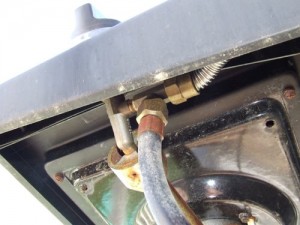 First off I want to caution you not to mess around with your gas lines if you’re not 100% sure what you’re doing. Also, you should check with your local code officials before you start a project similar to this. In this post I’m only showing you how to run a flexible gas line from the shut-off valve to the grill.
First off I want to caution you not to mess around with your gas lines if you’re not 100% sure what you’re doing. Also, you should check with your local code officials before you start a project similar to this. In this post I’m only showing you how to run a flexible gas line from the shut-off valve to the grill.
Step 1 – Remove Grill Regulator
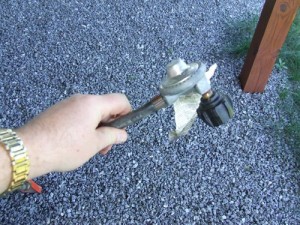 The first step is to remove the old regulator and supply line on your propane grill. The hose running from the propane tank on my grill has a regulator attached to it and then it connects to the bottom of the grill as you can see in this photo. I’ll be completely removing the regulator because I’m attaching the grill to the house propane supply which already has a regulator on it to drop the pressure.
The first step is to remove the old regulator and supply line on your propane grill. The hose running from the propane tank on my grill has a regulator attached to it and then it connects to the bottom of the grill as you can see in this photo. I’ll be completely removing the regulator because I’m attaching the grill to the house propane supply which already has a regulator on it to drop the pressure.
As you can see I’ve completely removed the grill regulator and I’ll keep it in case I need to take the grill some place and hook it up to a portable propane tank. Take a close look at the fitting used to attach the regulator hose to the grill because you’ll need the same fitting on your new gas line.
Step 2 – Connect Flexible Gas Line To Grill
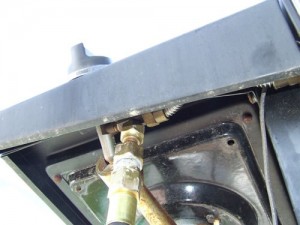 I went to my local propane supplier and had them make me a 12 foot long rubber gas line. They supplied me with the fittings I needed to attach the gas line to the grill and the shut-off valve below the deck. I’m not experienced with gas lines so I decided to have them make the gas line. As you can see in the next photo I’ve attached the new gas line to the same location that the old one was connected to on the grill.
I went to my local propane supplier and had them make me a 12 foot long rubber gas line. They supplied me with the fittings I needed to attach the gas line to the grill and the shut-off valve below the deck. I’m not experienced with gas lines so I decided to have them make the gas line. As you can see in the next photo I’ve attached the new gas line to the same location that the old one was connected to on the grill.
Step 3 – Connect Gas Line To Gas Shut Off Valve
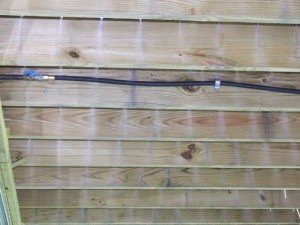 Next I drilled a hole in the deck, fed the gas line down below the deck and secured it to the framing with brackets. I ran the new gas line all the way back to the existing gas shut-off valve. I connected the fittings and made sure all of it was nice and tight.
Next I drilled a hole in the deck, fed the gas line down below the deck and secured it to the framing with brackets. I ran the new gas line all the way back to the existing gas shut-off valve. I connected the fittings and made sure all of it was nice and tight.
Finally I turned on the gas, tested the fittings for leaks with a soapy water solution. The barbeque grill works great and now we never have to worry about running out of gas right in the middle or preparing dinner or having a party.




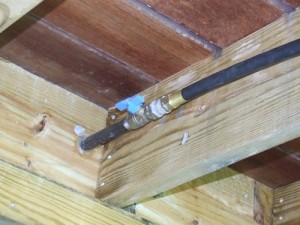









This is a great project for us to do before the summer ends. Thank you for the detailed how-to.
Thanks. This is exactly what I was looking for!
This got me started in the right direction. One thing I would add is to verify that your propane is supplied at the right pressure. As I understand it most systems have a regulator at the tank and one at the entry to the house. In my case the one at the house indicated 9″-13″ WC( water column)which is the correct pressure for the grill. If you don’t find the regulator or are unsure I would definitely have your propane supplier check it out before you proceed.
I wanted to be able to remove the grill and line at the end of the season so I had a quick disconnect fitting added into the hose assembly at the end where it attaches to the shutoff valve. These fittings are not cheap but don’t skimp if you need this feature. Use yellow teflon tape for any threaded connections you make. My grill has a compression fitting at the grill inlet so no tape was required there.
We grill a lot and this is a big improvement over schlepping propane tanks around.
Herb – You bring up a very important issue, one I think I pointed out but definitely worth repeating. You MUST have the proper pressure at the grill and if you’re not sure you REALLY need to call your local gas company and verify. Great idea with the quick connect!
Sorry about the redundancy. I see you did cover this well in your opening.
Herb – No worries! Definitely very important and worth mentioning several times. Thanks for the additional info!
I have an in-ground lp tank which used to be connected to the house. The former gas supplier thought he would be cute since i stopped buying form him, and he removed the fitting from the valve outlet to the pipe running to the house.
My only question: On an in-ground tank hookup, where all appliances inside the house have their own regulators, do you need a regulator at the in-ground tank, and if so, regulating the gas down to 11″ or is it 5″, or do we just rely on the regulator for each appliance?
Ernie – I’m not a licensed gas fitter so I’d rather not comment on this particular situation. You REALLY should check with a licensed gas fitter. I’m not aware of LP gas being run that way in houses, every application I’ve seen the pressure is dropped outside before it enters the home.
Hi Todd,
Great article, love your site!
We purchased a house last spring that had a propane line that runs from outside tank, to our basement and then branches off back outside to our read deck. There’s a shut off valve on the deck, from there a rubber line is hooked up to our grill, very similar to your setup.
I have been told that some gas suppliers do not allow this. Is there a safety concern I should worry about? I always make sure the grill is off as well as the valve outside when not in use.
Thank you,
Mainer82 – Thanks for the nice compliment. Not that I’m aware of, of course you could check with your gas company to find out their policy. Mine was roughed-in when we built the house and my local gas supplier is the one that set it up this way. So for me I’m ok.
The safety concern is that if high winds or (heaven forbid) a tornados rips your grill away, propane will spew from your disconnected propane feed making a dangerous situation even worse.
You really should have an accessible cutoff valve, and use it when not grilling.
hi,thanks for the information and howe to pictures.I’m ready to set mine up the same way.But I will first call my supplier to make sure there are no issues to be resolved.and if they can/will do it and the price.they moved my tanks from under my deck to a better area out by my drive way for better access in bad weather.thanks again for the information
Just had my Weber grill hooked up to my house propane (supplied from outside tank with regulator just before main line enters house). Flex line to grill (about 10 feet) comes from inside house out to deck and grill. Problem: grill does not heat to degree it did from the small cylinder. I noticed above, at start, to remove the grill’s little regulator. Is this really the thing to do, and will it likely solve the problem? Thanks!
The question is where does your grill connect to the propane with reference to the house regulator?
The new line the plumber installed to the grill comes off the house line manifold inside the house AFTER the regulator for the inside house line — the regulator is just outside the house. The manifold has flex lines from it to the furnace, water heater, etc. Per the above, sounds like I don’t need the regulator on the grill any longer, but there is conflicting recomendations about this on various web sites. Thanks!
Well I can’t tell you how to do this as I’m NOT a certified gas fitter I will tell you that the only way it will work properly is without the 2nd regulator. The gas pressure is already reduced when it enters the house.
Took off the grill regulator — like original post said to do — and it works fine now. Thanks!
I saw somewhwere else mention bolting the grill to the deck. Is that necessary, or just an extra safety thing for high wind/weather issues?
Also, my grill is a propane starter for charcoal. Is the fitting the same (ie, remove the regulator, hook up the hose, etc.) or are there other concerns that would play into it?
Thank you so much.
Jon – I’m sure bolting it down certainly makes sense from a wind point of view, especially if you don’t have a long flexible gas connection. I’m not sure about that type of grill, but if it uses a regulator then most likely it needs the same pressure propane. I’d check with your propane supplier to be sure.
Hello, My I just moved into a new home this past fall.
I noticed my deck has a propane hookup I’m assuming its for a grill.
Can I just hook up a hose to the grill I have from the hookup?
Carlos – Depends….you need to follow that gas line and see if it’s coming from the tank directly or from the regulator. If it comes from the regulator then you’d have to remove the regulator from your grill. The best solution is to have a gas fitter check for you.
Do people put a timer on the line in case the grille is left on?
Never heard of it…not a bad idea though
Hi folks. Couple of thoughts here.
1. Yes, the grill needs to be attached to the deck or patio if it is permanently plumbed to a gas supply. You might be able to waive this requirement if you have a quick connect that can break away, but I wouldn’t.
2. The regulator on a “house propane tank” is almost always set to a pressure similar to a “grill propane tank” (9 to 11 IWC). Check both, and if they are the same, you should not use a second regulator on the grill.
3. Rubber hose should not be used for permanent hookups. Use copper tubing and attach it well to the structure. You can use a piece of rubber or flex for the last piece that goes to the grill, after the last shutoff valve.
Disclaimer: I am an expert but I am not a licensed gas fitter in your state. Use this information at your own risk.
Some great advice on this page. I’m doing a similar installation but I’m going to make one significant change to what the topic starter did.
I’m running flexible 1/2″ copper tubing from the large propane tanks right to the grill and at that point, just behind the grill and to the side I’m going to place the shutoff valve and then hook a flex line from that valve to the grill.
That way the valve is easily shut off when the grill is not in use.
Thanks Todd. I like Steve’s method of using 1/2″ copper tubing from tanks to the bbq. Then a shutoff valve followed by a flex line. Sounds like what my gas pro recommended. Thank you both.
I had a plumber who is a NH licensed gas fitting install the valve and connection on my deck of a new home being built. He used black iron gas pipe, and included a sediment trap, running up a deck post to a weather resistant valve/ hose connection box. My concern is that black iron pipe outdoors is high maintenance, requiring paint. Any idea on what would trigger the need to use black iron pipe for this?
It’s done all the time….just hit it with Rustoleum….it will last for years.
Can you connect a home propane tank to a blackstone griddle?
Good article and advice. I hooked up my propane grill as you explained but I can not get the grill to heat below 350 With only one burner on the lowest setting the grill reached 350 quickly.
Using 2 burners on the lowest setting gives me 500 and all three at the lowest setting is 600. It appears that I’m getting too much propane. Would an additional regulator for the grill remedy this?
Thanks and again nice post.
Time for a gas fitter/plumber. Sounds like you may be hooked directly to the propane without a regulator..and that’s dangerous. I wouldn’t use it until you have a professional check it out.
Thank you just what I was looking for been a contractor for 40 years not much of a plumber
Thank you very much for this wonderful article, we are about to have a heating and plumbing expert set this up at our cottage (connecting our propane BBQ to the large propane tank that heats the building). Just wondering if it is worth all the effort to do this, as opposed to just hooking up the BBQ to a smaller (eg 20lb) portable tank? There seem to be quite a few things that could go wrong if not installed properly or the connection breaks down somewhere. I’m not sure whether I should spend the money to have this done? Pros/cons….
One of the BEST things I’ve EVER done! You won’t regret it at all!
Thank you so much! You instruction really helped me!!!
I connected my propane grill to my house propane supply after the whole house regulator. My grill at low temp setting heats to 500.
I thought I needed another regulator. I attached the regulator that came with the grill to the grill supply line. I had to purchase an adapter for the propane grill tank end. Installed these and now it will not heat above 150. Any suggestions to get this grill going?
Thanks
My brand new propane gas grill has a “crimped” connection to the grill controls. Flex hose extends down to a gas regulator and “knob” for connection to a portable propane tank. How do I eliminate the grill regulator and connect to the grill hose with my house flexible hose that has a female 3/8 threaded connector? Is there any way to “disable” the grill gas regulator? I have seen “fittings” advertised that would connect from the grill “knob” to the house 3/8 female fitting.
Most grills have a threaded fitting, if not you may be out of luck.
I plan on installing my gas grill on my deck which will be connected to a flex hose which will be connected to a copper tube connected to cast iron pipe. The installer will put in a quick release and shut of valve. Is it necessary to remove the wheels on the grill to minimize movement?
I have a high pressure (unregulated) propane line running from my 100 gallon LP tank to my house. I was thinking about “tapping” into this line (replacing an elbow with a tee) and connecting with a high pressure hose to my weber grill (leaving the regulator on the grill intact). This would only be for emergency use in the event of a power outage. Will this work?
Thank you.
Good Site. I have a question that seems to be simple (if there is such a thing.) I am moving my propane tank 5 ft away from it’s current position as suggested by my propane supplier so it will exceed the 10′ distance from structure code.
I want to use the 3/4″ stubbed up pipe that is currently there for a BBQ hookup. So, I will be adding a tee to the top of the existing 3/4″ stubbed up pipe. One side of the tee will have a plug for the future BBQ, the other side of the tee will have an elbow and piping to go back into the ground 24″ deep and run 5′ to an elbow then up out of the ground to the location where the new LP tank is located. The LP supplier will take it from there with the regulator and associated parts. I will be using black iron pipe with rust stopper paint and also gas pipe wrap. Do you see any problems with doing this or do you have any suggestions?